
How Cities of the Future Could See Cars Parked for Good
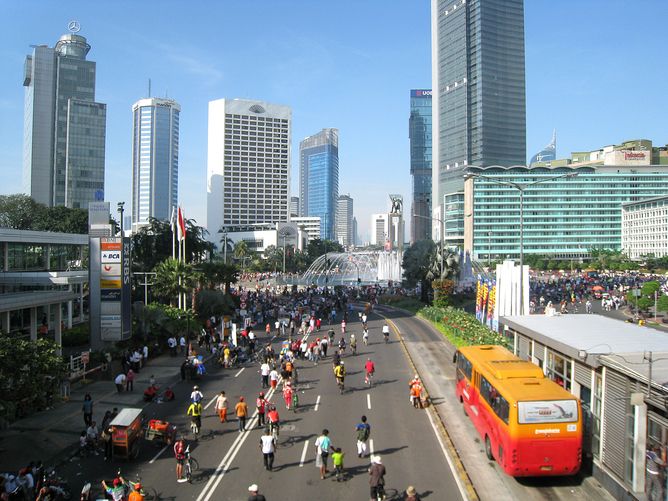
This article was originally published at The Conversation. The publication contributed the article to LiveScience's Expert Voices: Op-Ed & Insights.
Is a car-free city possible? In many European cities walking and cycling already account for more than half of all journeys. In Britain, the Sustainable Travel Demonstration Towns project between 2004-08 showed it’s possible to increase the number of people getting out of the car, encouraging sometimes up to nine times more journeys by foot or bike.
A large study carried out by researchers at the Universities of Leeds, Oxford, Salford, Manchester, and East Anglia, Visions 2030 explored different ways to increase the amount of walking and cycling in the UK. This would improve public health, and considerably reduce the effects of carbon emissions in towns and cities by cutting traffic congestion, as stop-start traffic is the most polluting cycle of vehicle’s engines.
Our current journey patterns reveal there is great potential for change, as nearly two thirds of trips are less than 8km in length (38% under 3km), while 6% of car trips are under 1.6km. Here the car’s efficiency is at its lowest, and the potential to easily swap it for other modes of transport is greatest. The rationale is partly to do with sustainability, but also improving the quality of life in our urban areas.
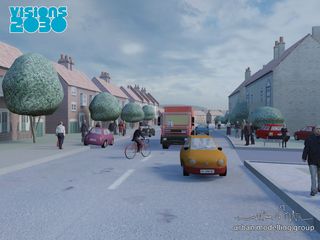
The aim was to find ways to encourage more walking and cycling in cities for the year 2030. Initially, this involved a lot of consultation to gather ideas about what the future might look like, and how cycling and walking could be better integrated into the design of towns and cities. This led to designing three different future visions.
European best practice
The first vision has walking and cycling account for around 45% of trips, a big increase on the UK’s 2010 figure of less than 30%. In this vision there is universal (or near) application of current European best practice in relation to walking and cycling in towns and cities.
Society is very similar to today’s and the government systems at national and local levels are essentially the same, though there is a heightened focus on the need for planning, in all sectors. The mode of transport split for this vision is 32% walking, 13% cycling, 25% public transport and 30% car.
Sign up for the Live Science daily newsletter now
Get the world’s most fascinating discoveries delivered straight to your inbox.
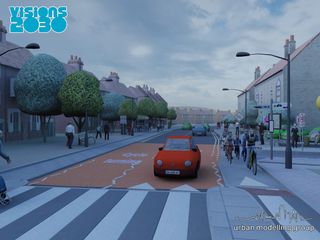
Car-free transport
This vision is aimed at changing society’s values to encourage urban areas where walking and cycling account for around 60% of urban trips, with vastly improved public transport taking care of a further 35%. This vision entails substantial provision to support walking, cycling and public transport, and represents a very large change in attitudes and move away from our car-centric society.
This has been brought about by major changes in society and values. Government is very different, more de-centralised, and with polices c-oordinated predominantly at the local level. In this vision split is 37% walking, 23% cycling, 35% public transport, and 5% car.
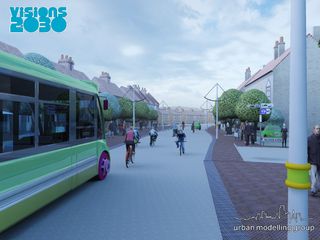
Localised energy efficient future
This is a response to serious long term fuel shortages or high costs, where hugely increased use of leg-power on foot and by bike accounts for around 80% of journeys. Society chooses to deal with the transport implications by focusing on walking and cycling within cities. Strong national government provides the direction for change, but also more power to decentralised local government than at present. The split for this vision is 40% walking, 40% cycling, 15% public transport and 5% car.
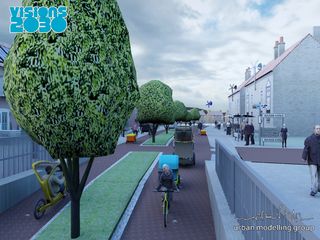
We created visualisations and animations to give a better impression of how the three future visions of our hypothetical city of around 200,000 people would look, and outlined narratives to explain what might plausibly happen between now and our visions for 2030. We carried out public surveys of adults and children to gauge how people responded to the proposals, how they would affect their lives, and how they might want to change them.
Good intentions
There were a number of significant findings from these surveys. Exploring general attitudes towards walking and cycling, respondents complained of poor support which, where provided, was rarely respected by drivers, and inconsistent. Sometimes long travel distances or complex household routines thwart good intentions to walk and cycle, as do concerns over road safety (for cyclists) and fear of crime (for pedestrians).
We found considerable hostility from cyclists and pedestrians to the idea of “shared space” for different modes of transport, with respondents strongly preferring segregated routes. Streets' aesthetics and environmental aspects were felt to be almost as important as their function. But in all cases, there seemed to be considerable disagreement about what the future of walking and cycling should be, with no single ideas held by the majority of each group.
We took our models, hypothetical narratives, and survey responses to decision makers in local authorities in Leeds, Norwich and Kirkcaldy, to explore how they might put our ideas in to place in their own districts, each with its own complexities and problems. We also held one workshop with national level decision makers.
These discussions were immensely useful. They identified problems and barriers to achieving the kinds of futures we imagined, but also highlighted the level of willingness among decision makers to get involved in such an exercise and think beyond the bounds of their day-to-day roles. Not once were we told our ideas were impossible, and in many cases we developed firmer ideas of just how those futures may be achieved.
Miles Tight receives funding from the Engineering and Physical Sciences Research Council.
This article was originally published at The Conversation. Read the original article. The views expressed are those of the author and do not necessarily reflect the views of the publisher. This version of the article was originally published on LiveScience.












